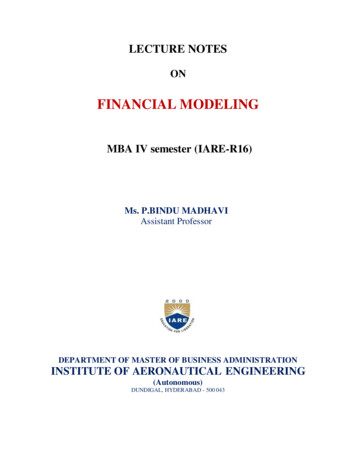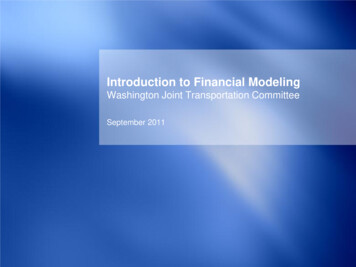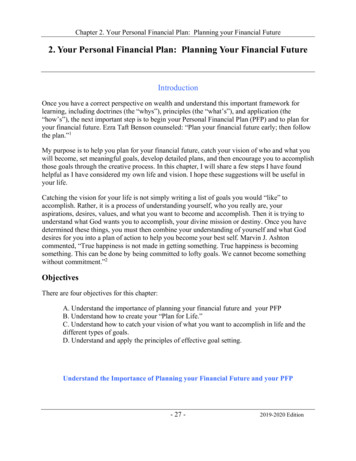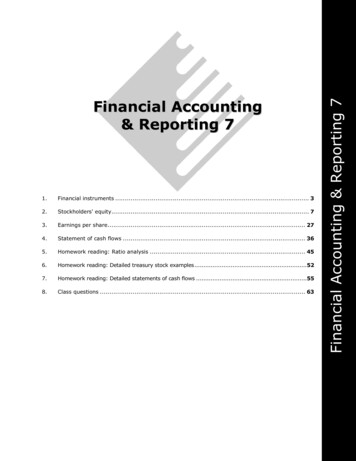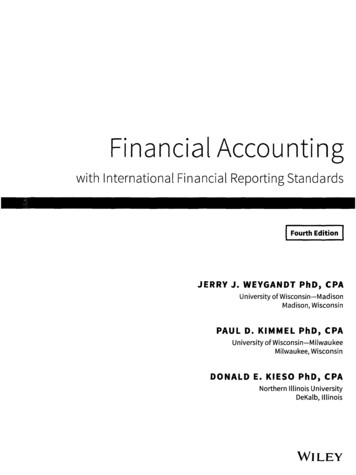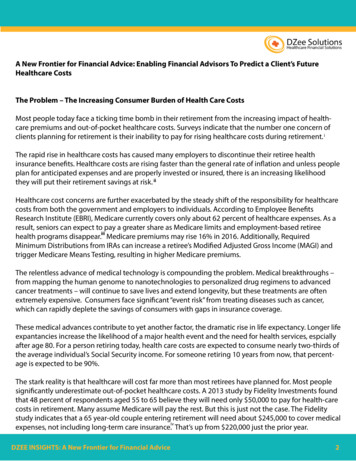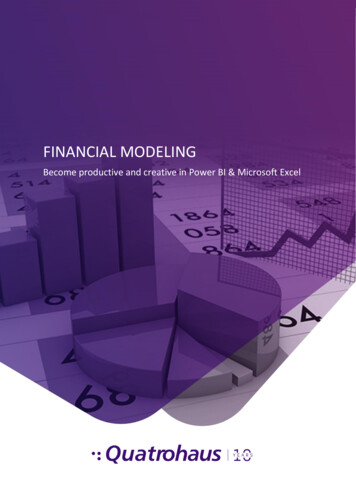
Transcription
FINANCIAL MODELINGBecome productive and creative in Power BI & Microsoft Excel1 Page
Contents2020 Calendar3Excel Essentials4Advanced Excel5Data Analysis and Dashboard Reporting6Advanced Data Analysis and Dashboard Reporting7Financial Modeling in Excel8Advanced Financial Modeling in Excel9Budget Modeling in Excel10Advanced Budget Modeling in Excel11Power BI12Advanced Power BI13Other Products14Contact Details152 Page
2020 CalendarNo.CourseZambiaZimbabwe1Excel Essentials24th -25th March27th – 28th April2Advanced Excel26th – 27th March29th – 30th April3Data Analysis & Dashboard Reporting26th – 27th May23rd – 24th June4Advanced Data Analysis & DashboardReporting28th – 29th May25th – 26th June5Financial Modeling in Excel28th – 29th July25th – 26th August6Advanced Financial Modeling in Excel30th – 31st July27th – 28th August7Budget Modeling in Excel22nd – 23rd September27th – 28th October8Advanced Budget Modeling in Excel24th – 25th September29th – 30th October9Power BI19th – 20th October17th – 18th November10Advanced Power BI21st – 22nd October19th – 20th NovemberDuration for all courses is two (2) days3 Page
Excel EssentialsThe CourseMost professionals use Microsoft Excel on a daily basis for number crunching but have not received formaltraining on use of the software. This results in underutilisation of excel and results in many professionalsspending more hours working in Excel than desired. This two (2) day practical course, is packed with ExcelEssentials which every professional must know.Learning Outcomes An overview of what Excel is and what you can use it for. Handle a large dataset with ease i.e. navigating, viewing etc Get skills on referencing cells. Writing a formula once and drag/copy thereby creating calculation blocks. Knowledge to name cells and range. Writing formulas in English to improve clarity. Make use of functions in Excel to manipulate data Apply formatting to improve on presentation and readability. Data validation allows you to control the inputs made by the end user. You will learn how to createvalidations in your spreadsheets. Convert a range to table and explore the benefits of creating a table. Create charts and tables with boardroom quality The confidence and knowledge to move on to the next level - Advanced Microsoft ExcelCourse Content Summary Overview of Excel Modifying a worksheet and developing a workbook Cell Referencing Naming Cells and Ranges Formulas & Functions Tables Formatting Data Validation ChartsTarget AudienceA must for all Excel Users4 Page
Advanced ExcelThe CourseMany times we are stuck in the office trying to manipulate data and come up with reports. Microsoft Excel hasquicker ways to find solutions by taking advantage of the built-in functions available in Excel. Save time bylearning these functions and tools. This two (2) days course is full of practical examples.Learning Outcomes Ability to customise Excel to meet user’s needs. The knowledge to nest other functions with the “IF” function to make it more useful/powerful The ability to use these key formulas for mapping, matching and comparing data. Skill in naming a range using formula to allow auto updating. Modify charts and filter by date or any other useful dimension. Master the full suite of summing and counting formulas, from the basic SUM to the powerfulanalytical formulas such as SUMIFS. Understanding of how to locate errors in formulas and manage them in your spreadsheets usingformula. Ability to audit reports in Excel using available tools. Know how to link MS Excel file to MS Word and MS Powerpoint. Recording/Writing own macros to turn several procedures into a click of a button Share and protect your workbooks.Course Content Summary Customising Excel Logical Functions – IF (), AND (), OR () Lookup Functions – VLOOKUP (), INDEX (), MATCH () Dynamic Naming of cells and Ranges Charts Summing and Counting Error Management Formula Excel Auditing Tools Embedding and Linking An Introduction to VBA Protecting Workbooks or Specific Cell AreasTarget AudienceDaily/ Heavy Excel Users5 Page
Data Analysis and Dashboard Reporting in ExcelThe CourseBig Data is on the rise, a robust Data Analysis model with interactive dashboard reports is undoubtedly key forbusiness success. Get the skills to develop and automate your own data analysis models to summarise, presentand communicate the meaning of your data clearly and concisely in this two (2) day course.Learning Outcomes Guiding principles of data analysis Summarise data using formulas Reconciling data using formulas Skill in using the consolidation feature to consolidate. Dynamic charts. Create reports using pivot tables Putting together all the pieces in Excel to build a robust model with excellent dashboards forpresentation.Course Content Summary Introduction and Managing Data Summarising and Analysis Reconciliation Multiple Sheet Models Consolidations by Position and by Category Charts: Outstanding Charts such as Combo and Waterfall Pivot Tables Finalise Auto Updating ReportsTarget AudienceAccounting and Finance ProfessionalsProgram Analysts6 Page
Advanced Data Analysis and Dashboard Reporting in ExcelThe CourseTurn data into useful information with ease. Data available to us today is overwhelming and can keep you inthe office until odd hours. This course gives you the skills to analyse data and design dashboard reports tointerpret and communicate. The two (2) day course offer you the opportunity to develop a model fromscratch.Learning Outcomes Streamline model building by applying best practice functions, tools and techniques Ability to build a data analysis model from scratch. Skill in using excel tools which are faster than using formulas. Knowledge to up a data model and then create a pivot table. Create dashboard to produce boardroom quality reports Well presented dynamic model. Protect your work in Excel to avoid undesirable changes by other user. Enhance Data VisualisationCourse Content Summary Data Analysis Theory And Data Relationship Data Analysis Model Design More Data Analysis Tools in Excel Create reports that can be updated by appending input Auto-Updating Charts Data Model: Using two data sources to create a pivot table Dashboard Design Making Dashboards Interactive Adding Icons, Sparklines, Images and Logos to Dashboards. Presentation of Model ResultsTarget AudienceAccounting and Finance ProfessionalsProgram Analysts7 Page
Budget Modeling in ExcelThe CourseMost companies get into the Budgetary Period without an approved budget. Year after year professionalsmanually number crunch during budgeting time. Change requests cause sleepless nights. Budget modeling is apractical two (2) day course designed to give professionals the agility demanded by the corporate world today.Giving clear demonstration of modeling techniques required to construct efficient flexible budgets in Excel.Learning Outcomes Navigate Excel with confidence numerous Excel shortcuts to improve your productivity Build a complete budget workbook using Excel, with account worksheets linked into a summaryworksheet Link budget data into Microsoft PowerPoint and Word documents Improve worksheet design using formulas, such as IF, VLOOKUP, and Conditional Formatting Create charts and graphs for budget presentations Prepare budget estimates and scenarios with ease Link together cells, worksheets, and workbooks Design and produce a budget depicting the future with precisionCourse Content Summary Preparing budget templates Explore static, flexible and rolling budget Restrict inputs using Data Validation Excel Functions for Budget and Financial Analysis- if () and VLOOKUP () Create and Consolidate Departmental budgets Budgeting for capital expenditure vs. operational expenditure Consolidating departmental budgets and linking to Financial Statements Building Scenarios using drop down Creating targets in the budget USING Goal Seek Method Management Reporting- Variance Analysis using Conditional FormattingTarget AudienceBudget and Program AnalystsAccounting and Finance Professionals8 Page
Advanced Budget Modeling in ExcelThe CourseMost professionals have accepted that budgeting processes are tedious and take long to complete, involving aback and forth process. This view can change if you can utilize Microsoft Excel to the fullest in preparation,reviewing and reporting on the budget. While professionals have full knowledge on rules and regulations thatgovern the process of budgeting, there is need to enhance skills in the knowledge of Excel functions and toolsthat help to develop budget models which can be used for years to come.Learning Outcomes Build a complete budget model using Microsoft Excel Planning techniques such as what – if Analysis and Scenario manager Sensitivity analysis using Data Tables Improve budget model flexibility using formulas Understanding how links work Insert budget trendiness and perform simple regression Make use of custom views to improve budget presentation Create charts and graphs for budget presentations Presenting the budget on a dashboard Tips on presenting an overview Protecting workbooks or specific cell areas of the budgetCourse Content Summary Preparing budget templates Preparing budget model One way and Two way Data Tables Managing linked workbooks Excel Functions: Offset (), Indirect() Using decision logic and what-if analysis Consolidation Options when budgeting Building Scenarios using combo boxes Custom Views Graphical analysis and trendiness Creating a Budget DashboardTarget AudienceBudget and Program AnalystsAccounting and Finance Professionals9 Page
Financial Modeling in ExcelThe CourseThis two (2) day course is designed for business professionals who need to explore the practical usage ofadvanced excel functions in a financial model. By creating your own user-friendly financial model, you willlearn to translate business concepts into a structured format to identify weaknesses and predict futureperformance.Learning Outcomes Knowledge of the guiding principles of modeling. Using excel tools to customize. Apply logical, lookup and other functions when modeling. Ability to effect changes to the model from a central point and make changes for specific item. Effect changes in economic factors to a financial model. Ability to assess a project. Link the key financial statements when budgeting.Course Content Summary Modeling Overview Excel Tools Essential Formulas Financial Modeling Techniques – flagging, tier tables Modeling Economic Factors- inflation, exchange rates Analyzing Key Financial Data Presenting your ModelTarget AudienceAccounting and Finance Professionals10 P a g e
Advanced Financial Modeling in ExcelThe CourseIn this volatile business environment, being able to accurately model and forecast is a critical skill for businessprofessionals. Build on your existing modeling skills and apply new techniques to better analyse financial data,predict revenues and costs to justify business decision in the most time-efficient and effective way. With a lotof systems in the market, Microsoft Excel still stands out. Come and stretch its capabilities in this two (2) dayscourse.Learning Outcomes Guiding principles of modeling. Applying advanced functions in modeling. Develop a model using current trends. Read and understand spreadsheets created by colleagues with no modeling skills Rebuild inherited models from colleagues. Create to predict your business drivers. Link the key financial statements and their relationship. Knowledge of one of the fastest way to create financials through use of a pivot. Create a dashboard to produce boardroom quality reportsCourse Content Summary Theory and Best Practice. Advanced Functions. Template approach, typical layout, structure and flow. Reading an Unstructured Models. Rebuilding an Inherited Model with errors. Financial Forecasting. Creating and Linking Financial Statements. Preparing Final accounts from Trial Balance using Pivot Tables. Automation: Creating a Dashboard and Switchboard.Target AudienceAccounting and Finance Professionals11 P a g e
Power BIThe CoursePower BI is a Microsoft tool that builds on Microsoft Excel capabilities while addressing some of itsweaknesses. If you have used a Data Model or Power Pivot , Power BI will not be entirely new to you. Theformulas which we refer to as DAX will also be familiar and easy to learn for good Microsoft Excel users. Thiscourse gives a sound introduction of Power BI while giving you all the relevant skills to manipulate, transform,model and visualise data beyond the capabilities of Microsoft ExcelLearning Outcomes Similarities of Microsoft Excel and Power BI Connect to data in Microsoft Excel and other databases Develop a model using current trends. Explore the drag and drop technology Understand how DAX works Ability to create matrices and charts in Power BI Build interactive dashboards Knowledge of one of the fastest ways to analyses data that Microsoft Excel can not handleCourse Content Summary Import data via queries Use queries to transform data into usable, meaningful tables Create a data model with relationships, custom sorting, a date dimension table Create a report in a Power BI Desktop environment Tips & tricks to enhance your reports with tooltips Use the various filter options, such as slicers, visual level filters and page level filters Use report level filters and drill through filters Set up interactions between charts Create a dashboard in a Power BI environmentTarget AudienceProfessionals involved in Data Analysis of Big Data12 P a g e
Advanced Power BIThe CourseCompanies are now gathering data than ever before which has remained untapped in most cases. Skills in dataanalysis, Business Intelligence / Business Analytics are highly valued as they are invaluable in deriving forecastfactors and predictive analysis. It is the same B.I. tool used by professional analysts and data scient
Financial Modeling Techniques –flagging, tier tables Modeling Economic Factors- inflation, exchange rates Analyzing Key Financial Data Presenting your Model Target Audience Accounting and Finance Professionals . 11 P a g e Advanced Financial Modeling in Excel The Course In this volatile business environment, being able to accurately model and forecast is a critical skill .

